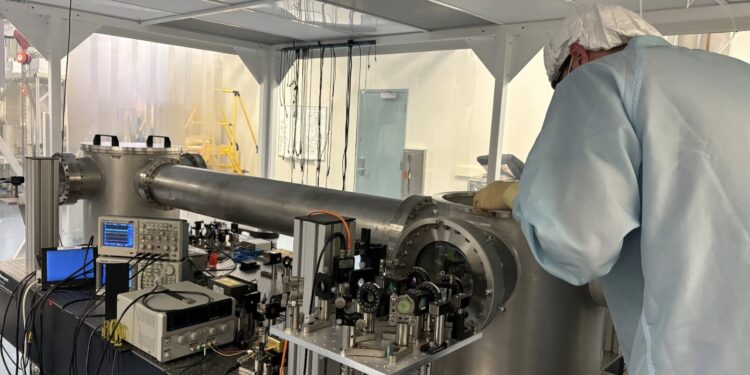Experimental facility at MIT, photo by Swadha Pandey. Our four-mirror detector is housed inside two steel vacuum chambers connected by a pipe. The platform in front of the near vacuum chamber supports optics that direct laser light into and out of the chamber. Credit: Pandey, Hall and Evans.
MIT researchers recently published the first results of an experiment to search for axional dark matter by probing the birefringence of electromagnetic waves induced by axions. Although these results, published in Physical Examination Lettersdid not lead to the observation of signals associated with these hypothetical dark matter particles, they established a new technique for searching for axions using a tunable optical cavity.
“The experiment was proposed in 2019 as part of a collaboration between our laboratory and our colleagues at the MIT Center for Theoretical Physics, as we thought about new ways to search for a hypothetical dark matter particle called an axion,” Evan Hall, a research scientist at MIT’s LIGO lab, told Phys.org.
“Any observable interaction between axions and standard matter would have to be very weak. We realized that the problem of finding a weak signal was a very similar problem to that of detecting gravitational waves, which is another type of very weak signal. detected only recently.
After various discussions and theoretical considerations, Hall and his colleagues realized that the lasers and optical tools currently used by the LIGO experiment to detect gravitational waves could be reused to conduct axion searches. This gave rise to the Axion Dark-Matter Birefringent Cavity (ADBC) experiment, which began collecting data in 2022.
“We wanted to demonstrate experimentally how to use these tools to perform an axion search,” Hall explained. “Light comes in two polarizations: horizontal and vertical. Axions, if they exist, are thought to convert one polarization to the other. In our lab, we use a laser to generate vertically polarized light, and we look for everything clue indicating that axions have vertical polarization converted some of this light to horizontal polarization.
The detector on which the ADBC experiment is based is composed of 4 mirrors arranged to form an optical cavity (i.e. a structure that traps light). This optical cavity stores and recirculates light beams from a laser thousands of times, which would enhance weak axion signals.
Experimental setup: bowtie cavity with mirrors A, D, B, C. The polarized pump field ^𝑠 from a 1064 nm Nd:YAG laser enters the cavity at mirror A and is locked onto the cavity at l using a Pound-Drever-Hall lock. ^𝑝 polarized sidebands generated by an axion-like particle (ALP) at cavity splitting frequency 𝜔𝑎=𝜔sp resonate in the cavity. Heterodyne reading is performed using a pump and a signal field transmitted to mirror C. Credit: Physical Examination Letters (2024). DOI: 10.1103/PhysRevLett.133.111003
In the early stages of the experiment, Hall and his colleagues used the detector to search for axions with masses around 50 neV (about 10–40 grams). Notably, another UK-based research team recently looked for axions with masses around 2 neV using a device resembling that used at MIT.
“Our work showed that this new type of cavity can be tuned to expand the range of possible axion masses that can be searched for,” said fourth-year doctoral student Swadha Pandey. student at MIT.
“Specifically, we showed that the cavity can be tuned by adjusting the angles of its four mirrors. Tunability is an important criterion for making the device useful for searching for dark matter. Since no one knows what the mass of axions, we must search over a wide range of possible masses.
Initial results from the ADBC experiment place constraints on the coupling of axion-like particles and photons. Although they have not detected axions so far, they could inspire additional research efforts aimed at detecting these hypothetical dark matter particles using optical cavities, potentially contributing to their experimental discovery.
“Having shown that this method can work over a wide range of axion masses, the next step would be to build a larger and more sensitive experiment,” added Pandey.
“Such an experiment would use more laser light, so that there are more photons interacting with the axions, and the experiment would be larger, to increase the time that the photons can interact with the axions. Automation of the mechanism Tuning and intelligent designs for mirror coatings are also essential for scanning the full available range of axion masses.
More information:
Swadha Pandey et al, First results from the Axion Dark-Matter Biréfringent Cavity (ADBC) experiment, Physical Examination Letters (2024). DOI: 10.1103/PhysRevLett.133.111003.
© 2024 Science X Network
Quote: First results from the Axion Dark-Matter Birefringent Cavity experiment establish a new technique for searching for axions (October 18, 2024) retrieved October 18, 2024 from
This document is subject to copyright. Except for fair use for private study or research purposes, no part may be reproduced without written permission. The content is provided for informational purposes only.



